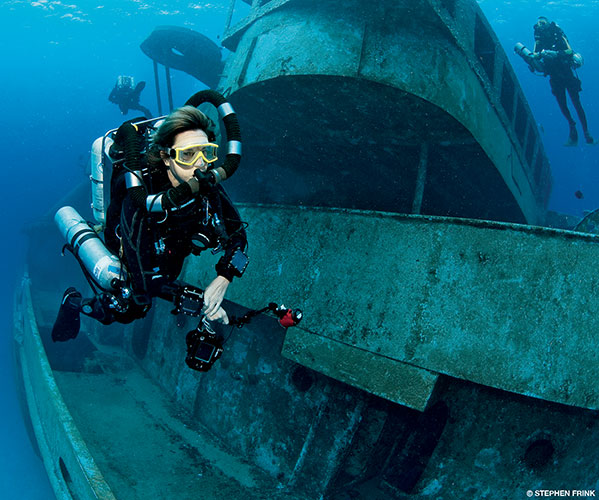Oxygen Toxicity
By Divers Alert Network

from oxygen toxicity. Photo Courtesy: DAN/Stephen Frink
Oxygen toxicity is a serious condition, and many divers struggle to understand it. We know that monitoring oxygen exposure is important to our safety, but we may not know what happens if we exceed safe exposure limits or why those limits even exist. Following training guidelines and planning dives conservatively can reduce risk somewhat, but learning how oxygen toxicity affects us and how we can prevent it can mean the difference between a fun dive and one that ends in injury.
What is oxygen toxicity?
Exposure to high levels of oxygen can have many harmful effects on the body, but there are two primary types of oxygen toxicity that affect divers.
The first is pulmonary oxygen toxicity, which typically occurs with prolonged exposure to elevated levels of oxygen. It often begins with inflammation of the upper airways that then spreads to the lungs. Manifestations of pulmonary oxygen toxicity include alveolar collapse and damage, decline in lung function and acute respiratory distress syndrome (ARDS). Pulmonary oxygen toxicity is mainly of concern to divers doing very long technical dives (in the range of six to 12 hours) and divers doing repetitive technical dives over a period of days or weeks.
Central nervous system (CNS) oxygen toxicity affects the complex of tissues that makes up the brain and spinal cord and can be even more detrimental to divers because it can arise suddenly, causing vital tissue damage and possibly seizures. CNS oxygen toxicity can occur with very short exposures to significantly elevated partial pressures of oxygen and can potentially affect any diver breathing a compressed gas mixture containing oxygen. Divers should be able to calculate and willing to respect both the depth and time limits for their chosen breathing gas. Extreme exposures to oxygen can have various other effects including hyperoxia-induced myopia (nearsightedness), but these are less common and rarely life-threatening.
Understanding how molecular oxygen disrupts the CNS requires an understanding of how the human nervous system works. The nervous system comprises two opposing sides: the sympathetic and parasympathetic nervous systems. Every organ in the body is controlled by one or often both of these sides. Simply put, the sympathetic nervous system activates the body and prepares it for action, while the parasympathetic nervous system calms it down to promote recovery.
Within the central nervous system, nitric oxide (NO) is excreted by various cells and used to suppress the activity of the sympathetic nervous system and widen blood vessels. Normally, a fraction of these NO molecules bind with reactive oxygen species (ROS), which are byproducts of cell metabolism. The unbound NO molecules are left available to control the sympathetic nervous system. When the body is exposed to too high a partial pressure of oxygen, all NO molecules can be bound to ROS, leaving none to suppress the sympathetic nervous system. When sympathetic activity becomes extreme, the body releases enormous quantities of adrenaline and noradrenaline in a reaction called an adrenergic storm. This storm can cause seizures, narrowing of the arteries, and a spiking of blood pressure and heart rate that may lead to capillary damage, compromised gas exchange, cell or tissue death. Seizures that occur underwater are often fatal.
Who is at risk?
Rebreather divers, nitrox divers, and divers breathing gases with high percentages of oxygen are at risk for oxygen toxicity. Exceeding depth limits, failing to respond to a rebreather failure or making an inappropriate gas switch can quickly put a diver at risk of CNS oxygen toxicity. Mitigating these risks is not difficult, but it takes some preparation. Understanding – and complying with – training guidelines for switching gases at depth, calculating breathing-gas maximum operating depths (MODs), and responding to rebreather failures can effectively minimize your risk of an incident.
Accurately planning for your oxygen exposure with both your primary dive plan and a backup is critical. It is also important to practice responding to rebreather or technical equipment failures and develop a safe bailout procedure.
In the event of an injury requiring recompression, additional exposure to oxygen is guaranteed with treatment; it’s not a bad idea to account for the additional oxygen exposure of recompression treatment. Fortunately, CNS oxygen toxicity in a hyperbaric chamber is not particularly dangerous since there is no risk of drowning. Operating within limits and employing appropriate risk mitigation are two of the best ways to protect yourself from oxygen toxicity. Understanding the causes and effects of oxygen toxicity can help keep you safe.
For more information on safe diving practices visit www.DAN.org/health
One Response to “Oxygen Toxicity”
Leave a Comment








Tyler Johnson
That’s interesting that the wrong amount of oxygen could be deadly to humans. I always thought that since it was necessary for us to live, it would be totally safe. I could see how that would make it important to make sure that things like medical oxygen are dispersed at the proper rate so that nobody becomes ill.